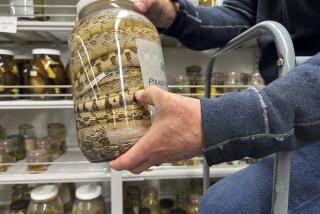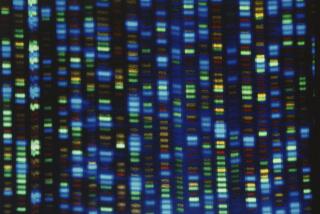Mouse Genome Is Offered Free on the Web
- Share via
Geneticists in the United States and Britain have completed a sophisticated draft of the genome of the mouse, which they are making generally available on the Internet--a boon to researchers who use the rodent for studying a host of human ailments.
The huge amount of data covers about 96% of the animal’s genome. The information will also be key to understanding the nearly completed human genome because the two mammals are biologically similar. Mice are important as a research tool--used to probe everything from diabetes and Down’s syndrome to asthma and atherosclerosis.
“It’s totally cool. It’s well ahead of where I think even the most optimistic would have predicted,” said Dr. Francis Collins, director of the National Human Genome Research Institute, which co-funded this latest phase of the mouse genome effort with the Wellcome Trust, a British research-funding charity.
A year ago, a group of scientists working for Celera Genomics developed their own map of the mouse genome. But they only allow other researchers to use it if they pay a fee of $8,000 to $13,000 annually for access--out of the price range of many researchers. The new work, by contrast, is being made available free.
“It’s incredibly important to put this information into the public domain,” said Joe Takahashi, a geneticist at the Howard Hughes Medical Institute at Northwestern University in Evanston, Ill., who uses mice to study the nature of biological rhythms.
Having the mouse genome will greatly speed up research, scientists say--indeed, it already has, because portions of the data have been dripping into the public domain for some time.
Students used to spend entire graduate-school careers locating a gene of interest or figuring out its structure.
Now such steps can be accomplished within hours or days, said Marc Tessier-Lavigne, a neuroscientist at the Howard Hughes Medical Institute at Stanford University, who uses mice to study how nerves wire up during development.
“It represents an enormous, enormous timesaver,” he said.
A fully completed mouse genome, which will cover all but some highly repetitive stretches of DNA that are too difficult to analyze, is scheduled for 2005. But things are scurrying along so fast that it probably will be wrapped up earlier, Collins said.
The current draft was put together by a consortium of scientists at the Whitehead Institute in Cambridge, Mass., Washington University in St. Louis, and the Wellcome Trust Sanger Institute and European Bionformatics Institute in Hinxton, England.
The draft involved the assembly of data from 33 million different chemical reactions, the scientists reported. It is more advanced than was the human genome at an analogous stage, due to improved lab technology as well as sophisticated software developed by members of the consortium.
“It’s sort of a ‘gee whiz’ moment--we’ve got it, we’re confident of it and we’re turning it over to everyone,” says Dr. Robert Waterston, head of the Washington University team.
The consortium has not yet compared the mouse genome to the human genome for clues to our strikingly similar biology yet obvious dissimilarities in traits such as size, brain power and furriness.
But they have noted some similarities and differences.
The mouse genome, they report, is about 15% smaller than the human genome. A total of 22,500 genes have been located so far. Scientists predict they will ultimately locate about 30,000, a similar number to that predicted for humans.
There are some clear differences: Mice, for instance, have more genes directing the production of smell receptors than do humans.
But most of the genes appear structurally very similar to the human set, implying that they do the same job. Differences between mouse and man may depend more on how genes are turned on and off than on the structure of the genes themselves, researchers say.
Scientists are especially intrigued by a quarter-million genome regions that are extremely similar in human and mouse but don’t seem to be part of traditional genes.
Since these regions have been stable through 100 million years of evolution--the time believed to have elapsed since the common ancestor of mice and humans existed--they are presumably very important, said Eric Lander, director of the Whitehead/MIT center. But no one knows what they do.
“It’s exciting and humbling, as it should be,” he said. “It’s the genome thumbing its nose at us and saying, ‘There are lots more mysteries than are contemplated in your philosophy.’ ”






